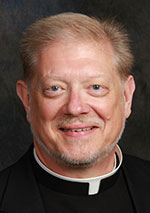That All May Be One / Fr. Rick Ginther
As followers of Christ, we are called to a radical love of all
 (This column is the second in a two-part series on anti-Semitism.)
(This column is the second in a two-part series on anti-Semitism.)
I pick up where I left off last month.
Eastern European Jews throughout Western Europe become the “face of fear.”
Communism overtook Russia in 1917. Some of its leaders were Jewish, such as Leon Trotsky. A connection of all Jews to communism began in people’s minds.
With the dissolution of the Russian, Ottoman and German empires, the post‑World War I era became a time of bitter rivalry and nationalism.
Fear of the Jews also ironically found its roots in a pre-war book produced by the Tsarist secret police. Titled Protocols of the Elders of Zion (and later deemed a forgery), this book was widely believed to outline a “world conquest” mentality by Zionist Jews. Updated, translated into many languages and disseminated widely, this volume captured the imaginations of the likes of Henry Ford, Charles Lindberg and even Winston Churchill.
In Germany, the rise of the Nazi party during the 1920’s added to the gross mis‑characterization of Jews. They were “the outsider,” the “disrupter,” the ultimate “other,” the “profiteers.”
The crushing burden of war reparations to the victorious Allies destroyed the German economy.
The Great Depression roared into Europe in the early 1930’s. The stage was set for a Nazi victory in 1933. As militarization took hold, the economy blossomed. The Nazi anti-Semitic rhetoric evolved at the same time from virulent lies into fists, broken glass, yellow stars and pervasive restrictions.
The Holocaust was born. Indifference in the West took hold. Some like Ford and Lindberg believed in a Jewish/Zionist conspiracy, speaking out against this fiction.
And sadly, a Detroit Catholic priest, Father Charles Coughlin, perpetuated the connection between Jews and communism, and supported Hitler and Mussolini on his radio program. He was silenced by the Vatican, but continued on the air until 1940.
In the aftermath of World War II and the revealing of the extent of the Holocaust, anti-Semitism quieted. But not for long.
The creation of the State of Israel resulted in the birth of a radical Islamist rhetoric and violence we still have today.
The communist/Jewish connection found fresh life in the McCarthy House Unamerican Activities Committee of the 1950s.
Occurrences of anti-Semitic rhetoric and violence have risen to a frightening level in the last few years. This is true in the European Union. As anti-Semitism has risen there, many member countries provide police security for synagogues 24 hours a day.
There is a decided unease among Jews in our country today. In just one year, anti-Semitic incidents have risen 57 percent, mostly vandalism, as was the case earlier this year at a synagogue in Carmel, Ind. But after my first column in this series was published, Pittsburgh violently underscored how hate too often rises to brutal violence. An attack at a synagogue in that city in late October resulted in 11 people’s deaths.
Mayor Joseph Hogsett of Indianapolis said on Oct. 29: “Anti‑Semitism—or any other ideology of hate—grows when we are apathetic about what is true and what is not, when we are not vigilant about what is right and what is wrong.”
We know what is right. We cannot remain indifferent. We know 20th-century history.
As followers of Jesus Christ, a Jew, we are called to a radical love and a rooting out of any form of “ism” in our own hearts.
Please God, may we be open to the truth, in our world, in our heart.
(Father Rick Ginther is director of the archdiocesan Office of Ecumenism. He is also pastor of Our Lady of Lourdes Parish in Indianapolis.) †
 (This column is the second in a two-part series on anti-Semitism.)
(This column is the second in a two-part series on anti-Semitism.)